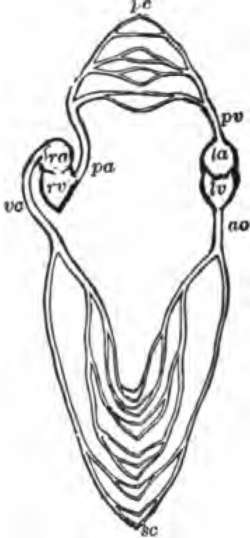The Course Of The Blood
Description
This section is from the book "The Human Body: An Elementary Text-Book Of Anatomy, Physiology, And Hygiene", by H. Newell Martin. Also available from Amazon: The Human Body.
The Course Of The Blood
From what has been said it is clear that the movement of the blood is a circulation. Starting from any one chamber of the heart it will in time return to it; but to do this it must pass through at least two sets of capillaries; one of these is connected with the aorta, and the other with the pulmonary artery, and in its circuit the blood returns to the heart twice. Leaving the left side it returns to the right, and leaving the right it returns to the left; and there is no road for it from one side of the heart to the other except through a capillary network. Moreover, it always leaves from a ventricle through an artery, and returns to an auricle through a vein.
In what direction do the valves of the veins allow the blood to pass? Make a diagram illustrating the action of the valves. In what veins are the valves most numerous? Why does a vein with many valves appear knotted ? How may we see the dilatations of the veins opposite the valves? Where are the valves of the veins most frequently placed?
If we followed the blood course steadily from one chamber of the heart what would we find in time? Through what must blood pass before returning to the chamber of the heart which it leaves?
There is then really only one circulation; but it is not uncommon to speak of two, the flow from the left side of the heart to the right through most of the body being called the systemic or greater circulation, and from the right to the left through the lungs the pulmonary or lesser circulation. But since, after completing either of these alone, the blood is not again at the point from which it started, but is separated from it by the septum of the heart, neither is a "circulation" in the proper sense of the word, for a circulation implies that any object at the end of its course is again exactly where it was at the commencement.
The Portal Circulation
A certain portion of the blood which leaves the left ventricle of the heart through the aorta has to pass through three sets of capillaries before it can again return there. This is the portion which goes through the stomach and intestines. After traversing the capillaries of those organs it is collected into the portal vein, which enters the liver, and breaking up there into finer and finer branches like an artery, ends in the capillaries of that organ, forming the second set which this blood passes through on its course. From these it is collected by the hepatic veins, which pour it into the inferior vena cava which carries it to the right auricle, so that it has still to pass through the pulmonary capillaries to get back to the left side of the heart. The portal vein is the only one in the human body which thus like an artery feeds a capillary network, and the flow from the stomach and intestines through the liver to the inferior vena cava, is often spoken of as the portal circulation.
Through what does blood always leave the heart? To what does it return? How many circulations are there really? What is meant by the systemic circulation? What by the pulmonary? Why is neither a true " circulation" in the proper sense of the word?
How many sets of capillaries does some blood pass through in a complete circulation? What portion of the blood is it? What vessel does it enter after traversing the capillaries of the stomach and in-testiues?
Diagram Of The Circulation
Since the two halves of the heart, although placed in proximity in the body, are actually completely separated from one another by an impervious partition, we may conveniently represent the course of the blood as in the accompanying diagram (Fig. 63), in which the right and left halves of the heart are represented at different points in the vascular system. Such a diagram makes it clear that the heart is really two pumps working side by side, and each engaged in forcing blood to the other. Starting from the left auricle, la, and following the flow, we trace it through the left ventricle, and along the branches of the aorta into the systemic capillaries, sc; thence it passes back through the systemic veins, vc. Reaching the right auricle, ra, it is sent into the right ventricle, rv, and thence through the pulmonary artery, pa, to the lung capillaries, pc, from which the pulmonary veins, pv, carry it to the left auricle, which drives it into the left ventricle, lv, and this again into the aorta.

Fig. 63. Diagram of the blood vascular system, showing that it forms a single closed circuit with two pumps in it, represented by the right and left halves of the heart, which are separated in the diagram, rα and rv right auricle and ventricle; la and lv, left auricle and ventricle; αo, aorta; sc, systemic capillaries; vc, venŠ cavŠ; pa, pulmonary artery; pc,pulmonary capillaries; pv, pulmonary veins.
Where does this vein carry it? In what does it end? Into what vessels is the blood of the capillaries of the liver collected? Where do they convey it? What chamber of the heart does it first reach? Through what must it pass to get back to the left ventricle? How does the portal vein differ from all others in the body? What is meant by the portal circulation?
Continue to:
